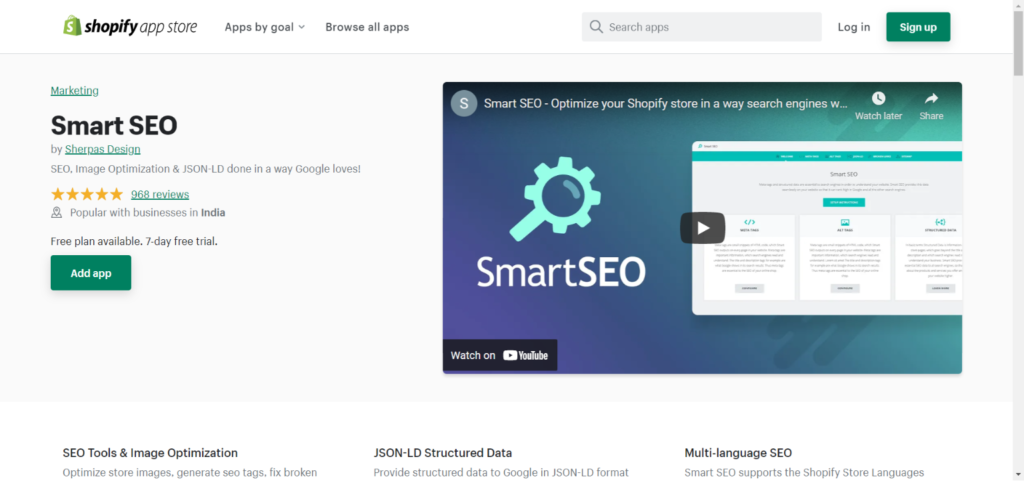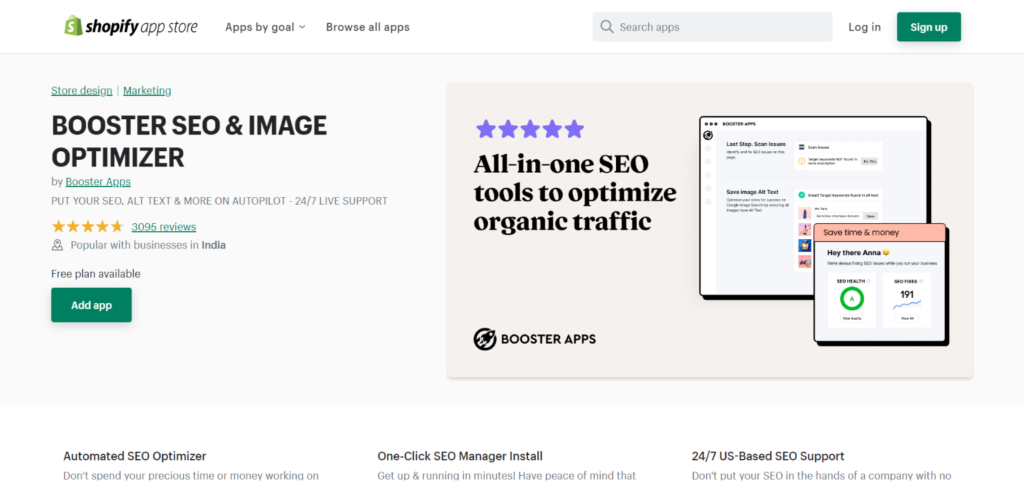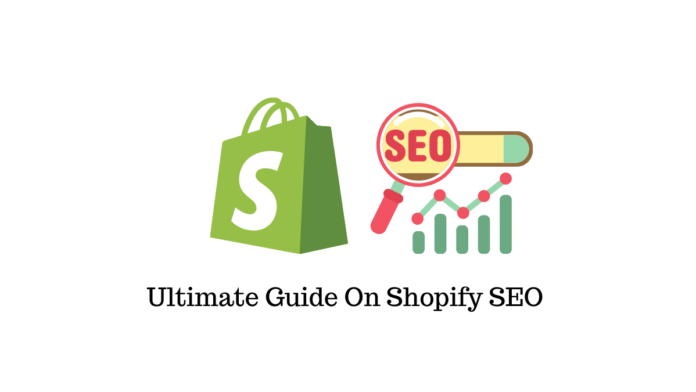Last updated - November 29, 2022
Internet merchants may use Shopify eCommerce to set up an online store and sell their products. Optimizing your Shopify online store for Google, Bing, Yahoo, and other search engines is a vital aspect in order to increase your brand’s visibility.
Shopify allows merchants to improve their store’s search engine ranking and make it easier for customers to locate their website and products. For search and user experience, Shopify SEO includes title tags, meta descriptions, URLs, websites, items, collections, and alt text for photographs, among other things.
Furthermore, for eCommerce shops, Google search is the primary source of traffic and income. Google is responsible for approximately 70% of all global desktop search traffic, with over 8 billion searches every day.
Using Google Analytics, Google Tag Manager, and Google Search Console to track your store’s performance is a good tactic.
Understanding Shopify SEO
Improving the content and technical layout of the Shopify website leads to enhanced quality and quantity of organic search traffic leading to the store. Any of the following activities will help you improve your Shopify SEO:
- Make sure your product pages have optimal page names and title tags.
- Shopify’s navigation bar could be improved.
- Incorporate the page’s target and secondary keywords into the text of the page.
Default Shopify SEO Features
The built-in Shopify SEO capabilities allow Shopify SEO rookies to simply optimize their Shopify sites, which is one of the reasons Shopify is so fantastic for SEO. Some of these features are as follows:
- Shopify generates the sitemap.xml and robots.txt files for the website automatically.
- The Shopify theme will build a title tag with your store’s name in it by default.
- You may modify the image’s alt text directly from the product page.
- Each page allows you to adjust the title tag, meta description, URL, and other elements directly.
Best Practices for a Successful Ecommerce SEO Campaign
1. Improve the structure of your Shopify website
The way your material is structured on the page has a big impact on SEO results. When customers can quickly and easily locate what they’re searching for, they’re more likely to stay on your site longer and visit more pages, which benefits your search engine rankings.
2. Enhance the customer experience
Now let’s look at some strategies to enhance your website’s user experience, which can help you rank better in search results.
- Boost the speed of your website: The accessibility of a website is connected to its speed. Visitors will not become frustrated if your website is smooth, simple to use, and everything moves quickly. As a result, they may be willing to browse around longer.
- Use a responsive design approach: Your Shopify store will look fantastic on any platform, including PCs, tablets, and smartphones, thanks to responsive design. Responsive themes may enhance the user experience and retain users on your site for longer periods of time.
3. Find the best target keywords
Any Shopify SEO tutorial would be incomplete without advice on keyword research, which is the cornerstone of SEO success. The simplest method to get started is to make a list of at least five core themes that clients care about that are closely linked to your product, rather than using sophisticated tools.
4. Make Your Shopify Product Pages More Effective
You should have a keyword list and a sensible site structure at this stage. The next step is to optimize store pages using keywords. Begin with your landing page.
5. Increase the number of links to your store
Backlinks are used by search engines to assess how the rest of the world views your website. Consider it SEO’s version of word-of-mouth. This is an off-page optimization method that is based on building your credibility and dependability.
Selecting the Best Keywords for Your Shop
Right now, your keyword list is probably rather lengthy. So, how do you cut it down and concentrate on the most important keywords? Let’s start with a few fundamentals.
1. Search volume: The bigger the search volume, the more visitors your site may receive. You can get volume data from SEMRush, but you can also get it from free programs like Google Keyword Planner.
When it comes to high-volume keywords, there is typically a lot of rivalry.
2. Competitors: The less competition there is for a term, the more likely you are to rank for it. SEMRush will once again provide you with keyword difficulty/competition (“KD”).
3. Relevancy: Is your product or category page relevant to the search term? This is a significant ranking component that is frequently overlooked. Stick to keywords that your items will actually fulfill. You are not deceiving Google.
4. Objective: You want to target keywords with commercial intent. In most cases, you can determine the purpose just by glancing at a keyword.
Ecommerce Site Structure
Your search engine rankings are influenced by how your site’s pages are ordered and structured. It also has an impact on your user experience (UX). Basically, you want to make it as simple as possible for real people and search engines to locate things in your business.
The structure of the site soon becomes intricate as you add and delete goods and categories. If you can get this right from the start, you’ll save a lot of time in the long term.
- Make sure your site’s structure is straightforward but scalable as your business expands.
- Every page on your site should be as close to the homepage as feasible.
Simplicity is often overlooked. You don’t want people using the back button to navigate your site, going around in circles seeking what they’re looking for. You don’t want to have to restructure and reconfigure your site’s structure every time a new product category is added.
What are Canonical Tags?
Thin content, as well as content duplication, are two of the most typical difficulties for eCommerce sites. Many of the thin content and content duplication scenarios arise as a result of the website structure’s many internal layers, such as filters and attribute-focused sites with few items that are also featured on other pages.
Thin content: This refers to the assumption that an eCommerce site has less real text than, say, a blog or software site. Consider how many thin content pages were developed as a result of random product attributes and product filter pages. Some of those sites may simply have one or two goods listed on them.
Content Duplication: In the world of search engine optimization, the term “content duplication” refers to content that is visible on multiple web pages.
Canonicalizing a page tells Google that this URL is the “master version” that you want to see in search results. This is useful in circumstances when there is duplicate material since Google will detect it. If you don’t employ canonical tags, Google may take the following actions:
- Wading through too much duplicate content makes it difficult to find original stuff.
- Diminish your capacity to rank.
- Select the incorrect “master version”.
Ecommerce Search Engine Optimization (On-Page SEO)
Let’s talk about how to optimize your two most valuable pages now that you’ve done your keyword research and your site structure is ready to go:
- Pages for each product category.
- Pages dedicated to certain products.
The Fundamentals
If you’re already using Shopify, you’re probably aware that it comes with certain built-in SEO tools.
- We already discussed canonical tags.
- The sitemap.xml and robots.txt files for your website are produced.
- Title tags with your store name are generated by themes.
- Social media connection and sharing tools are necessary in all themes.
However, some features will necessitate your optimization skills:
- You may add your keywords to the title tags and meta descriptions by editing them.
- You may incorporate your keywords in the alt text for photos by editing the alt text.
- You can put your keywords in the file names.
- The URLs for blog posts, webpages, goods, and collections are all customizable.
Keep in mind that your title tags and descriptions are visible to Google. So, the first step is to get on the top page of Google. The next stage is to encourage searchers to come to your site.
Modifiers like “Deals,” “Free Shipping,” and others might help you out. Because click through rate (CTR) is thought to be a ranking element used by Google. So it’s not enough to satisfy the search engine algorithm; you also need to capture the attention of searchers.
Select the appropriate URLs
There are a few URL rules to follow for best ranking, according to Rand Fishkin and the Moz team:
- Because Google values accessibility, your URL should be simple to read and understand by actual people.
- It’s still a good idea to use your keywords in URLs because they show up in search results.
- Long URLs are preferable to short URLs. It’s best if you keep it within 50-60 characters.
- Match the URL and page title as accurately as possible.
- Stop words such as “and,” “of,” “the,” and “a” should be avoided.
- Keyword stuffing and meaningless repetition will not fool Google and will make your store appear spammy.
When picking the URLs for your product and category pages, keep these criteria in mind.
Use long product descriptions on thin content pages
The content on your website is used by Google and other search engines to determine which keywords to rank your page for and how high your page should rank for each keyword.
So, if your product page only has a brief description and no more information, Google won’t have much to rely on.
As a result, you’ll notice product pages with richer descriptions, reviews, and other information.
To help Google’s algorithm work more efficiently, write comprehensive, in-depth descriptions for your items. Focus on your top items or products that rank at the bottom of the first page or at the top of the second page if your catalog is large.
The more you write, the more precise Google’s rating of your page may be and may provide you better chances to use your keywords.
The Pros & Cons
Pros
- Since the backend of most on-page SEO solutions is extremely straightforward, most on-page SEO implementations are relatively simple to carry out.
- Shopify provides all of the basic SEO features that most business owners want. For instance, automatic sitemap generation, canonical instructions, customized URLs, 301 redirects, adjustable title tags, and an editable robots.txt file are just a few examples.
- Shopify is a flexible platform, your online store will load quickly if you use a ‘lightweight’ design (which all of the free themes are).
- They have a reputation for consistently high uptime, which is beneficial to your eCommerce.
- Having dependable support to contact in regards to SEO when in doubt, is a huge plus.
- Shopify has a number of handy apps that may make your life simpler.
Cons
- Shopify, unfortunately, adds certain strings to some URLs that you cannot edit. A necessary ‘/products/’ in the URL of a product page, for example.
- You can build non-eCommerce content (for example, pages and blog entries), but it isn’t the most flexible system. As a result, using some content marketing tactics may not be sufficient.
- Some SEO elements are pre-installed. For example, it is not possible for you to access and alter your Sitemap.
- There are no subcategories available out of the box. Subcategories, or subcollections as Shopify refers to them, can be created. However, this necessitates tinkering with the code, which is not suitable for beginners.
Apps and Tools to Boost Shopify’s SEO
In this section, we’ll go through 5 tools and Shopify apps you may utilize to boost your site’s rankings.
Plugin SEO


This Shopify tool helps you focus on the SEO issues that need to be addressed, saving you time and money while improving your SEO. It checks page titles and headers, meta descriptions, speed, content, article structure, and more on a regular basis to ensure that your site is as optimized as possible.
Smart SEO


Smart SEO automates the creation of appropriate meta tags for a product, collection, blog, and article pages in your Shopify store, as well as alt tags for product photos, so you don’t have to.
SEO Image Optimizer


Because visuals are what sell your products, having a large number of them on your website is essential. Quality photographs, on the other hand, may be resource hogs, so you’ll want to employ an image optimizer like this one to keep your site running smoothly.
Yoast


Yoast makes it simple to optimize your site for the keywords you provide. You can check the SEO strength of all pages and articles and receive suggestions for improvement. The Google algorithm is continuously updated along with that you may edit numerous pages with a single click.
SEMRush


SEMRush will assist you in identifying underutilized and ignored keywords that may be leveraged to boost traffic and conversions. You may use the tool to look for top competitor keywords and check which sites are receiving the most organic search traffic.
Conclusion
While Shopify SEO takes time and effort, the rewards, such as enhanced search engine optimization rankings, high performance, and more sales, are critical to the success of your e-commerce business. To help your eCommerce site rank higher in search engines and get more organic visitors, follow the methods above. There are even additional Shopify eCommerce solutions for websites that may help you improve your SEO, such as integrating Shopify applications for SEO.











